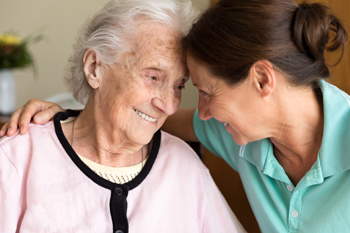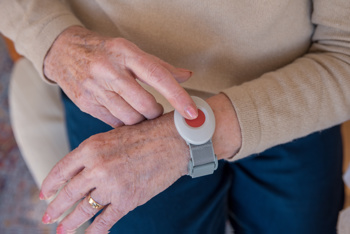
What is a Hospital at Home?
Hospital at Home (HaH) and Virtual Wards are both terms used to describe remote-based care. Hospital at Home is the term most commonly used by NHS Scotland but Trusts in England are now beginning to adopt the term and use the two interchangeably.
These models of care rely on the use of remote monitoring technologies and wearable devices such as pulse oximeters, blood pressure monitors, blood glucose meters, etc. to monitor a patient’s vital signs and behaviours within their home or a similar setting, such as a care home. The devices feed real-time information to clinicians via a remote digital platform, enabling them to make swift decisions if the person’s condition changes or a form of intervention is required.
Why do they matter?
Since Covid, the NHS has been under immense pressure. Congestion in hospitals is at an all-time high, delays in discharge have caused a backlog of patients, and 12-hour waits in A&E have become the new norm.
The Association of Ambulance Chief Executives (AACE) estimates that 32,000 patients suffered harm as a result of ambulance delays in May this year, with 148 people waiting over 10 hours to be taken to A&E — twice that of May 2023. What’s more, 14,000 inpatients were reported to have stayed in hospital who clinically did not need to be there during Covid, and this figure has been increasing by more than 10% since 2022.
Hospitals at Home have the power to reduce much of this friction by allowing patients to get the same standards of care they would get in a hospital at their home, thereby freeing up costs, resources, and precious clinical time. As of March 2024, there are approximately 11,635 virtual ward ‘beds’ across England, and it’s thanks to their implementation that thousands of hospital admissions were avoided last winter.
Patient benefits
Virtual Wards carry numerous benefits for patients, with the biggest being the ability to recover in the peace and comfort of familiar surroundings as opposed to a busy, crowded hospital ward. However, Hospital at Home patients also benefit from the following factors:
- Easier access to care
The lines of communication are open 24/7 for those receiving care on a Virtual Ward. Teams are also on standby to intervene and take the patient directly to hospital in the event of a medical emergency. - Low risk of illness
people are five times less likely to contract an infection on a virtual ward compared to a hospital. They’re also eight times less likely to experience functional decline. - Complete autonomy
Unlike a traditional hospital stay, HaH patients are able to pick and choose their food options and can decide what they want to watch on TV, what music they would like to listen to, etc. - Unrestricted visiting hours
Virtual Wards patients are not restricted to seeing loved ones at set times of the day. Family and friends can also receive real-time alerts if the person’s condition worsens or they display unusual behaviour that may warrant a visit. - Increased freedom
Virtual Wards enable people to remain at home for longer, thereby allowing them to continue with their normal routines and day-to-day activities, with the added peace of mind that their health is being constantly monitored by a health professional.
These benefits, as minor as some of them may seem, can have a substantial positive impact on a person’s wellbeing and mental state, both of which play a significant role in the recovery process. When a patient feels safe, comfortable, and reassured, they are more likely to recover sooner than they would if they were in hospital and are less likely to experience an episode that would cause them to be readmitted. This has been proven in various studies, with some Virtual Wards programs reporting a 50% reduction in readmission rates and 40.3% reduction in the average length of hospital stays.
In addition, those who have recovered on a Hospital at Homereport heightened levels of satisfaction compared to hospital recovery, with virtual ward case studies revealing an average patient satisfaction rate of 93.75%. This, in addition to more freedom, independence, and being able to spend more time with loved ones are reported as some of the biggest patient benefits.

Provider benefits
A collaborative, integrated approach is integral to delivering the best care and improving outcomes for patients and everyone else involved. Here’s how the Hospital at Home is helping healthcare providers to achieve this:
- More efficiency – Virtual Wards and HaH are designed for patients who can perform basic health checks themselves, such as attaching wearables and submitting their readings. This self-sufficiency reduces the need for care staff involvement.
- Increase capacity - Workforce shortages continues to be one of the most pressing issues in the NHS. Virtual Wards free up capacity in hospitals, enabling providers to allocate staff more efficiently and provide care to patients in urgent need of treatment.
- Data utilisation - Thanks to real-time reporting, clinicians have a holistic view of a person’s health and can make well-informed decisions about their care plans and treatment needs. This continuous flow of data also allows them to quickly detect changes in a person’s condition and take immediate action.
- Enhanced communication - Clinicians and nurses no longer rely on whiteboards and sticky notes to track patient health status. Instead, all necessary data is integrated into a single-solution system, allowing them to easily view and update patient records.
Addressing health inequalities
For those who live in deprived areas, getting access to healthcare can be a serious problem. Many people living in such areas may not always have the funds to afford the commute to A&E, nor be able to rely on a family member to take them. This often results in an ambulance being dispatched, which not only costs time and money, but also means people with urgent needs must then wait longer to receive medical attention.
Hospitals at Home bridge the widening gap on health inequalities by ensuring multi-disciplinary teams are at hand to check in on patients regularly. In the event an individual requires urgent assistance, they have access to a HaH team, who are on standby 24 hours a day to either visit the person at home, or take them directly to hospital if their condition worsens. This reduces the demand for ambulance services and ensures that patients receive timely care without the added financial burden of travel.
In addition, remote patient monitoring kits are provided for free by the healthcare provider and returned once the patient has been discharged from the Hospital at Home.
This promotes health equity and inclusivity and ensures that financial constraints do not prevent individuals from receiving the care they need.
Hospital at Home software
Staff and the technology used in Hospital at Home care models must be properly supported for these approaches to work effectively. Bed management and procurement, the proper monitoring of patient data, and the purchasing of care services all need to operate in tandem for both patients and healthcare providers to reap the benefits.
Using Access software, we’ve outlined a six-step process to how a Hospital at Home might work:
Patient identified as a suitable candidate for HaH:
A patient with acute-level needs can receive care in a Hospital at Home.
- Care plan created
Clinicians decide whether the candidate is to receive care in a care home or their own home.
- Access Adam Care Commissioning
Access Adam and other care commissioning tools aid in the procurement of all aspects of the care plan such as home care services and remote monitoring equipment. It can also enable approved, quality providers to continue provisioning the person’s care.
- Remote Patient Monitoring
Based on the needs of the person, the relevant remote monitoring tools are used to check vital signs, movement and more. Tools such as Access Assure can be used within the home to monitor movement patterns and alert any changes. These tools then link directly back to the Electronic Patient Record (EPR) such as Rio, used by the Trust.
- Access Patient Flow Manager (APFM)
Access Patient Flow Manager is used to keep track of patients within the virtual ward, pulling information directly from the EPR including relevant information and observations from the remote monitoring tools, and presenting it on bed cards. This makes it easy to complete a ‘virtual ward round’ and see which patients are in most need and alerts clinicians to those who need immediate care.
- Access Workspace: Data Engine
Access’ Data Engine extracts information from both Assure and Rio EPR before analysing the data for patterns and extrapolating it to predict future health outcomes.
Choosing the right software for your HAH care model
Remote patient monitoring (RPM) and tech-enabled care tools make up the bulk of the Hospital at Home operation and ensure clinicians have a clear and holistic view of a person’s health, enabling them to intervene if necessary. Proactive monitoring tools like Access Assure enhances clinical workflows by linking back to existing systems, giving healthcare providers full visibility of the care pathway.
Access Patient Flow Manager (APFM), Adam Care Commissioning, and Access Elemental are the three key software aides that health organisations and NHS-led Hospital at Home models can benefit from the most.
Virtual Ward whiteboard information is flagged by APFM, which provides key data related to the patient’s care journey. This includes details about their transition from hospital to their home or care home, as well as real-time updates from their new location via remote monitoring data feeds. In addition, APFM allows care teams to view all the information they could possibly need to take care of the person, ranging from risks and medication requirements to allergies, ensuring they always provide the appropriate care.
Access Adam plays an equally crucial role in a Hospital at Home as it supports its initial implementation. Whether this is by procuring continuing healthcare (CHC), social care, housing and transport, or other home care services, the software determines the most suitable provider according to the patient’s needs, then aligns them with the service. This has been shown to improve care quality and reduce care costs by as much as 5%.

Access Elemental is our Social Prescribing software that enables clinicians to connect and refer patients to the community via social prescribing link workers. Community-based services can include counselling for people with mental health problems, rehabilitation programs for chronic pain sufferers, and wellness/activity sessions based on arts, nature, or culture. These types of services can be beneficial add-ons to a person’s care plan and make recovery less stressful.
Social Prescribing referrals are handled by Access Elemental and sends detailed reports and updates on a person’s condition, needs, and experience with the services back to stakeholders such as GPs, charities, and the link worker(s).
Solutions to support the entire hospital at home
The Access Group’s suite of state-of-the-art products can support Hospital at Home processes end to end. From establishing and assigning beds to real-time patient monitoring, reporting, and service referrals – having the right tools, protocols, and practices in place now can ensure healthcare providers continue to deliver holistic, personalised care to patients, now and as future healthcare demands grow.
Keeping up with demand and ensuring healthcare quality remains high also requires moving away from reactive care to proactive care responses. Access is facilitating this shift with the help of products like our Rio EPR Virtual Pathway, which is supported by Access Technology Enabled Care (TEC) and serves as the primary software for clinician-patient interactions.
Access Assure is our latest integration which, together with our care planning software, further supports the Hospital at Home by detecting potential risks. Using the care planning app, the Assure home hub sends smart alerts to caregivers in the event a person’s condition changes, or they are at risk of having a fall or seizure while they recover at home. These effective monitoring solutions allow for quicker intervention and promote safer, more responsive care.
Hospital at Home and Virtual Wards-based approaches to care can save time, money, and drastically improve health outcomes if executed correctly. Their success requires robust, preventative software solutions, accurate and reliable data, and a collaborative team of the right professionals to ensure they work seamlessly.
Let Access equip you with the tools and support needed to bring the Hospital at Home and deliver exceptional care to your patients – get in touch today.
The NHS continues to scale up its Virtual Wards program across the UK, with the aim of reaching 40-50 Virtual Wards beds per capita, as outlined in its Long-Term Plan and 2023/24 Priorities and Operational Planning Guidance and the Delivery Plan for Recovering Urgent and Emergency Care. With acute bed occupancy rates at 92.6% between January and March 2024, now is the time to implement Hospitals at Home across the board and enact the change the health and care sector so desperately needs.
NHSE Virtual Wards Operational Framework
NHS England (NHSE) has updated its operational framework with new guidelines following the decision to expand the Hospital at Home (virtual wards) initiative across the UK. This update follows an analysis revealing virtual wards in the South East saved over £10 million last year through Hospital at Home services alone.
The revised framework sits in line with the NHS 2024/25 Urgent and Emergency Care Recovery Plan and includes the following mandatory requirements for Hospital at Home and virtual wards models:
- Strong governance led by a GP, consultant physician, or consultant practitioner.
- Operate daily from 8am to 8pm, with after-hours support available.
- Clear admission criteria and assessment protocols.
- Personalised care plans developed with patient participation in decision-making.
- Daily ‘board’ rounds led by senior clinicians, with input from the multidisciplinary team.
- Access to hospital-grade diagnostic services.
- Delivery of hospital-equivalent treatments and interventions.
- Utilisation of remote patient monitoring (RPM) and other technologies to ensure quality care.
- Optimised pharmacy services with medication reconciliation.
- Clear discharge procedures, including tracking patient length of stay.
Read our Virtual Wards guide for more information on how to establish your Hospital at Home service and ensure it meets the requirements of the NHS operational framework.

 AU & NZ
AU & NZ
 SG
SG
 MY
MY
 US
US
 IE
IE

